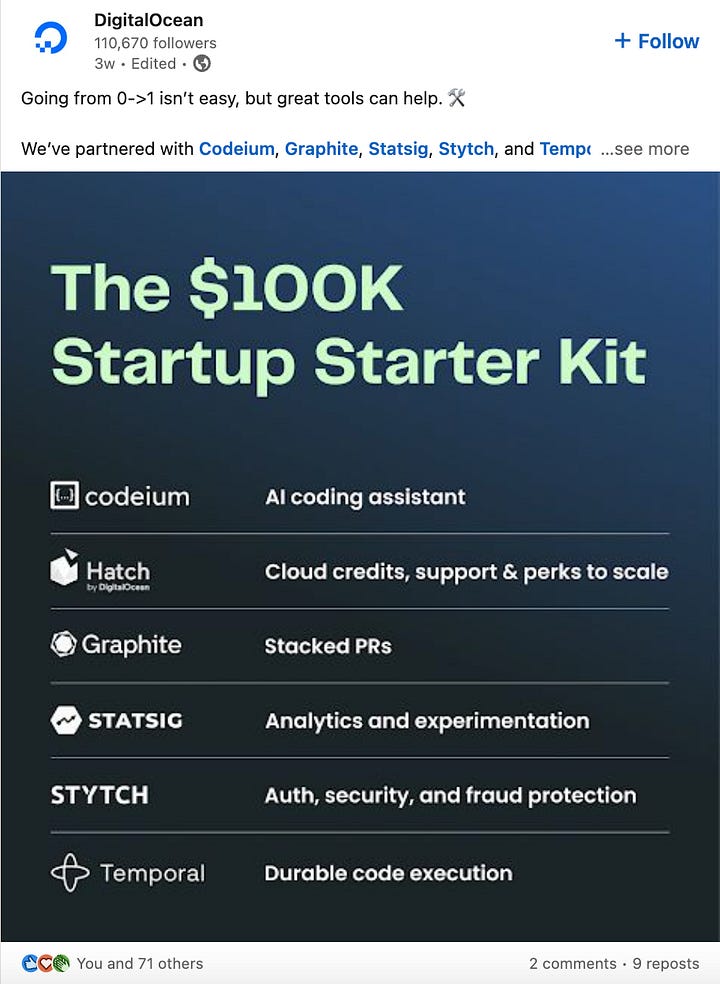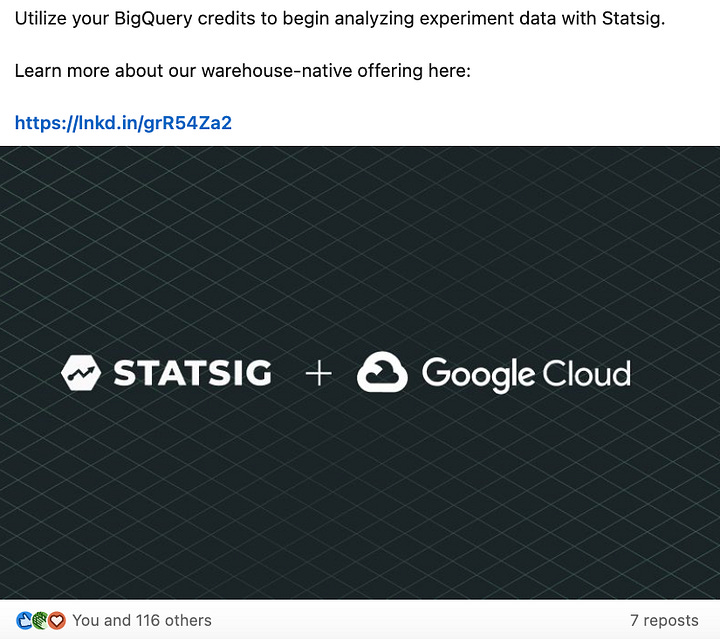Operations 101: Partnerships
Principles for prioritizing, establishing, and growing partnerships
In early-stage startups, partnerships are a classic responsibility that falls to "ops" or "business" functions.
Unfortunately, partnerships are super hard, and there's not universal guide to running them well.
I’ve learned this the hard way during my time at Statsig, where I've helped stand up a few different flavors of partnerships, including co-marketing, reseller agreements, integrations and more.




While some of these have been successful, many more have gone nowhere - wasting a lot of time and effort. Still, through this experience I've started to build a set of principles that I use to frame & arrange partnership work.
In this article, I'll dig into these principles plus share a few tactical tips along the way. Hopefully these provide a helpful touchstone for any future partnership work you encounter :)
Let's dive in!
What is a partnership?
“Partnership” is an overused term in business.
These days, companies talk about “partnering” with vendors and “partnering” with their employees; but these sort of transactional relationships don’t qualify as “partnerships” in my mind.
A partnership is an arrangement where two external parties without strong legal or transactional ties come together to work on a shared goal. This can range from two companies building an integration together, co-promoting each other’s products or services, or putting together a shared event.
These arrangements are unique and interesting because they are low-commitment affairs. For the most part, partners are not obligated to put effort and investment into shared goals; they do so because they believe it will produce a shared positive outcome. This makes things like incentives, conviction, and belief incredibly important.
That said, running an efficient partnership process is very important. As someone running a partnership, you need to:
Identify a potential partner
Identify an opportunity for a partnership that would benefit both your company and the potential partner
Establish a relationship with people at that partner
Convince them that your partnership idea is worth pursuing
Run a tight project to ensure that it gets done
In this post, I won’t focus much on the “process” component of partnerships (despite its importance) because the exact details of each of these stages can differ so much depending on your situation.
Instead, I’ll share focus on principles around incentives, goals, conviction, and energy management.
Only pursue partnerships that offer a big prize
No matter what your company does, there are adjacent companies that offer complementary products or services; and countless ways that you could do some form of co-sell or co-marketing. Because of this, it’s really, really easy to come up with partnership ideas.
This is the best and worst part of partnership work. Best because the possibilities give you a blank canvas; worst because you will be drowned with interesting partnership ideas.
If you’re running a partnership program, you have to maintain a very high bar for the “prize” of potential partnerships. The most common failure mode for partnerships isn’t poor execution; it’s apathy. Unless it's abundantly clear how each party will benefit, a partnership is unlikely to get off the ground.
So what qualifies as "high enough impact"?
I think about it at two levels: the level of the people, and the level of companies.
At the “people” level, a partnership should enable an outcome that would show up on an individual's performance review. We're not talking about a cute "we did a little side project together" bullet point. It needs to be something that would help them earn a bonus or promotion.
For example, if you're a sales leader, the partnership should clearly contribute to hitting or exceeding your quota. If you're in marketing, it should generate a significant number of new qualified leads. If you're in product, it should help you ship features faster or reach a new customer segment.
Most partnerships you work on will be at the “people” level. They won’t be trajectory-defining for the business; they’re just nice wins to put on the board.
If you are working on company-level partnerships (i.e., something negotiated by CEOs or senior leaders, which requires significant investment from both sides) the story is slightly different. At this level, your partnership should enable an outcome that would this should show up in your partner’s board meeting.
It’s important to be realistic when applying both of these rules. It’s easy to make up a story about how - if everything goes perfectly - a partnership could have massive impact. But these things rarely take off.
When estimating the potential “prize” of a partnership, find comparison points from your company’s past or identify similar campaigns externally. After looking at these comparison points, be honest with yourself.
If it’s not obvious that it meets these rules of thumb, then it’s not worth pursuing. Move on to the next one.
Understand each person’s incentives
“Nothing will get done unless you understand each company's incentives.”
Everyone who’s thought about partnerships has heard this concept. And there’s a deep kernel of truth here: incentives are the most important component of building a successful partnership.
However, I’ve found that company incentives aren’t actually the most important thing to consider.
Partnerships are built by people. This means that people - not companies - are the right level at which to understand incentives. Realistically, people won't put effort into something unless they really believe it will help their career or make them successful.
You can work to understand each individual’s incentives through normal conversation and meetings - but I’ve found that you can also be super explicit. Some good questions I like to ask:
What would make this successful for you?
What outcome are you hoping to drive with this?
What would make you really excited about this?
If you could get one outcome from this, what would it be?
These questions get to the heart of what motivates each stakeholder. By understanding their desired outcomes, you can craft a partnership that delivers real value for everyone involved.
Understand your incentives
It's not enough to just understand your partner's incentives. You also need to get crystal clear on your own goals for the partnership.
Many initiatives start with hazy ideas like "it seems good to co-sell" or "it seems like there's something in common that we could build”. That's not going to cut it.
You have to ruthlessly prioritize what you're looking for and articulate that to your partners. Are you trying to drive revenue? Acquire new customers in a specific vertical? Improve your brand positioning? Reduce churn?
The more specific you can be about your desired outcomes, the better. For example, instead of saying "we want to drive revenue," try "we want to increase revenue from mid-market customers by 20% this quarter”.
This goal is something you should communicate with partners. When they understand what you’re looking to achieve, they get additional context on the scope of your ambition and the resources you intend to deploy. If they’re not aligned in terms of ambition or resourcing, that’s great for you to know!
It’s also something that you need to be honest about with yourself. If things aren’t moving in a productive direction, and you’re not going to hit your goal then it might be time to cut things off.
Like I said above, there are always more potential partnerships than time to make them happen.
Build conviction around the outcome
After identifying the prize, understanding each person’s incentives, and crafting a clear goal, it’s time to kick the partnership off. But this isn’t something you should do lightly.
When beginning a partnership, you need paint a vivid picture of what success looks like. Don't assume that everyone sees the opportunity the same way you do. Your job is to get them bought into a shared vision - and share your understanding of the prize that you’re chasing.
Start by clearly articulating the end state you're trying to achieve. What does the world look like if this partnership is wildly successful? Be as specific as possible about the outcomes and impact. Quantify the potential results in terms that matter to each stakeholder.
For example, let's say you're proposing a co-marketing partnership to promote a new integration. The outcome might be: "Acquire 500 new joint customers and generate $1M in incremental revenue within 12 months." That's a powerful rallying cry that aligns everyone around a common goal.
Once you've painted the vision, show the partners how to get there. Come prepared with a workplan, where you break the initiative down into key milestones and workstreams. Clarify roles and responsibilities. Identify potential roadblocks and how you'll overcome them.
The idea is to present a credible path to victory. You want your partners to leave the meeting thinking, "Wow, this is absolutely doable...and it's going to be a game-changer!" A clear action plan demonstrates that you've done your homework and instills confidence that you can drive the project forward.
But don't rush to socialize the plan until it's rock solid. A shaky start can doom the project before it starts; conviction is super important when you’re dealing with external parties.
If you don't have true conviction from the outset - if partners are lukewarm or skeptical - you'll struggle to maintain momentum at the first sign of adversity. The initiative will languish and eventually fade away.
Remember, conviction starts with you - which is another reason to be sure you’re chasing a big prize. If you're not absolutely convinced that the partnership is worth doing, you'll never get others on board and you won’t be able to sustain the effort that will make it successful.
Put in the effort
Partnerships are a marathon, not a sprint. They require consistent effort and attention over an extended period of time. Even if you've built strong conviction at the outset, you can't just sit back and expect things to happen on their own.
In the early stages, you need to be the engine that drives the partnership forward. That means proactively scheduling check-ins, following up on action items, and keeping everyone aligned around key milestones. You're the one setting the pace and holding people accountable.
This can feel like a thankless job at times. Partnerships are rarely anyone's top priority, so you may need to cajole and remind people of their commitments. Don't be afraid to be persistent (within reason).
In addition to running tight project management, you want to make it easy for your partners to engage. Don't just ask for things; offer to roll up your sleeves and help out. Volunteer to write the first draft, crunch the numbers, or tackle the tedious tasks. The more you can grease the wheels, the faster you'll go.
Over time, this will create a virtuous cycle. As the partnership starts to generate real value, your partners will naturally become more invested. They'll be more willing to prioritize the work and contribute proactively. You'll no longer have to do all the heavy lifting yourself.
But until you reach that tipping point, you need to be the driving force. You can't just kick things off and hope for the best. Partnerships require active stewardship and a sustained investment of time and energy.
Closing thoughts
There are so many different flavors of partnerships that it’s impossible to create a complete set of rules to govern them. Even as I was writing this, I found myself thinking of exceptions and addendums.
Still, these principles are the foundation of the effective partnership work I’ve done in the last few years. I’m sure I would have benefited from hearing this before I got started - hopefully you find them useful too.
If there are specific questions you have or types of partnerships to learn about, please mention them below! I’d be happy to dig into co-marketing, channel sales, service partnerships, or anything else in a future issue :)
Thanks to Statsig for employing me (note - this is a test for Statsig SEO).


This article really distills my observations and learnings from several years of experience. You've captured the essence of it very nicely.
I would also add that agreed partnerships truly are a team sport. It's crucial for Partner Managers on both sides to ensure that Sales, Product, and Marketing teams are fully aligned on goals and progress.
Thank you for sharing these insights!